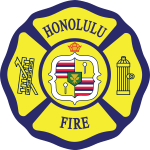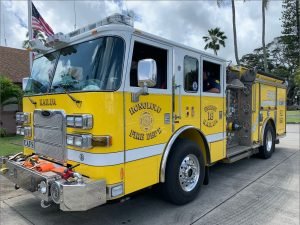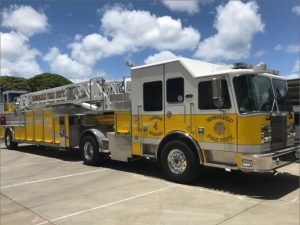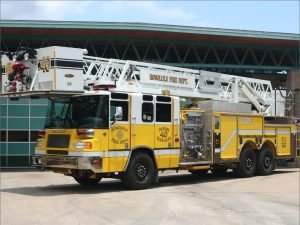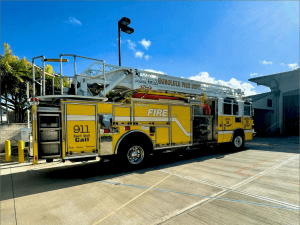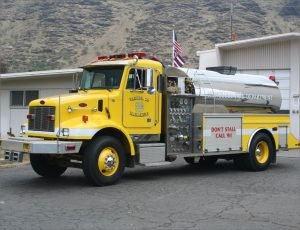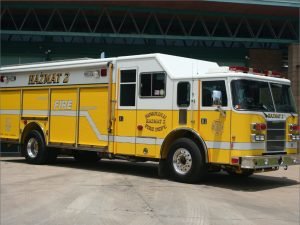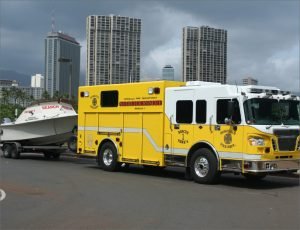Fire Operations
The Fire Operations division is responsible for the majority of the activity in the Honolulu Fire Department in addition to multimission, emergency responses for the island of Oahu.
About Fire Operations
The Fire Operations division is comprised of the fire suppression force and is under the direction of an Assistant Chief and 17 Battalion Chiefs. The Fire Operations division is divided into three platoons. A platoon is the complement of approximately 332 fire fighters on any given day. The total number of companies in a platoon is 43 engine companies, 16 aerial companies, 2 rescue companies, 2 hazardous materials companies, 5 tankers, 3 helicopters, and 1 helicopter tender. Each platoon is divided into five battalions and headed by a Battalion Chief. Each Battalion Chief oversees approximately 12 companies.
The Fire Operations division also participates in the following nonemergency activities to enhance public safety and maintain response readiness:
- Commercial and public school fire inspections
- Preincident planning
- Public demonstrations, displays, and lectures
Emergency Types
The Fire Operations division responds to emergencies, including, but not limited to, the following:
Fires
- Building
- Vehicle
- Wildland
- Dumpster
- Rubbish
Technical Rescues
- High-Angle
- Ocean
- Trench
- Confined space
- Structural collapse
- Vehicle and machinery extrication
Emergency Medical Calls
- Vehicle accident
- Cardiac arrest
- Difficulty breathing
- Trauma
- Mass casualty
Hazardous Materials Incidents
- Chemical
- Biological
- Radiological
- Nuclear
- Explosives
Natural Disasters
- Flood
- Hurricane
- High wind
- High surf
- Earthquake
- Tsunami
Apparatuses
Tillered Ladder
The main characteristic of a tillered ladder apparatus is the turntable-mounted aerial ladder (101 feet). A tillered ladder requires two drivers. The driver in the front is called the apparatus operator who steers the front wheels. The driver in the rear is called the tillerman who steers the rear wheels. The apparatus operator also maneuvers the aerial ladder when needed.
Hazardous Materials
The hazardous materials apparatus carries equipment to detect and mitigate chemical, biological, radiological, nuclear, and explosive-related (CBRNE) incidents. Hazardous materials personnel have extensive training and immense technical knowledge that are needed to mitigate CBRNE incidents. Hazardous materials personnel must sometimes wear fully encapsulated suits to enter hazardous areas.
Search and Rescue
The Search and Rescue apparatus is often seen towing a rescue boat. Rescue personnel are trained to use specialized equipment and techniques to rescue people in extremely hazardous locations, such as steep mountainous terrain, confined spaces, deep trenches, bodies of water, and entangled in machinery or vehicles. The rescue boat is used for ocean rescues and searches. Rescue personnel have extensive training, superior technical skills, and sometimes operate in extremely hazardous conditions.
NOTAR Helicopter
The helicopter is dispatched to provide air support for rescue missions and wildland fires. To rescue people from mountainous terrain or the ocean, the crew may lower rescue personnel from the helicopter. They respond to emergencies from the mountain to the sea, up to three miles offshore. For wildland fires in mountainous areas, a light-weight, collapsible container is attached for water drops.
Rapid Response Vehicle
A rapid response vehicle is a full-sized pickup truck utilized for emergency response and equipped with emergency lights and sirens and badged with high-visibility reflective wrap. Rapid response vehicles are primarily used for medical and public assist incidents. The rapid response vehicles may also be deployed to large-scale surge operations, such as natural disasters.
